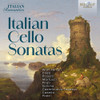Description
DESCRIPTION
The origins of the cello as a solo instrument, and of the kind of solo repertoire compiled in the present set, lie in the gradual emancipation of the cello from it's function as a primarily supportive, accompanying bass. This process began in the second half of the 17th century, firstly in Naples, and then farther afield across the Italian provinces and principalities. Yet the cello would remain an unequal peer of the violin, expressively aswell as technically, through the course of the 18th century, with low-string virtuosity centred instead on the increasingly obsolete viola da gamba (Marin Marais in Paris and then Carl Friedrich Abel in London). By the time of the 'Ottocento' (19th century), opera was the dominant force in Italian musical culture, with bel canto composers such as Rossini and Donizetti creating a public appetite for opera that eclipsed achievements by Italy's musical sons in other genres. Some of these composers who focused their energies instead on instrumental music, swimming against the operatic tide, remained in their native land, while others found a home (or were forced to find one) abroad. Giuseppe Martucci (1856-1909) is one who stayed. A gifted pianist, he bypassed the operatic path and wrote music with a kind of fluent synthesis of Italian lyricism and German, dialectic approach to form that reached an early peak in his Cello Sonata of 1880. Yet Martucci, as a teacher of composition in Bologna and then Naples, urged the teenaged Alfredo Casella (1883-1947) to study abroad. Casella's father was a cellist and his mother a pianist. Several other close relatives were cellists, and his godfather was Alfredo Piatti. It makes sense therefore that, returning from his studies in Paris with Gabriel Faure, he would unite cello and piano with a thorough grasp of their contrasting idioms. Ildebrando Pizzetti (1880-1968) is among the few composers in this set whose entire career centred in Italy, and he wrote a substantial body of instrumental music. While Respighi may be the composer most associated outside Italy with Mussolini's fascist regime, he received no state commissions - unlike both Casella and Pizzetti. Many Jewish Italians such as Mario Castelnuovo-Tedesco (1895-1968), on the other hand, would end up exiled on the other side of the world (Hollywood in his case), but before the war Castelnuovo-Tedesco succeeded in reinventing an essentially Romantic model (of both form and harmony) for his own time with his Cello Sonata Op.50 of 1928. From seven years earlier, Pizzetti's Sonata of 1921 is a more gloomy, even tortured affair. The Cello Sonata of Francesco Cilea (1866-1950), while unmistakably cast as an 'operatic' work from it's opening solo, features a protagonist scarcely burdened by the existential angst to be found in comparable works from northern Europe. But then, like most of the above sonatas, it is a youthful composition, written in 1888 before hits such as La Gioconda established Cilea at the forefront of the verismo movement. Like Cilea, Ermanno Wolf-Ferrari (1876-1948) is known for his operas (in his case, comic operas), but unlike Cilea's cello sonata, Wolf-Ferrari's Opus 30 dates from the final three years of his life and belongs to a mature output of instrumental music that is recently being recovered from the shadow of his operatic achievements. In their different ways, Cilea, Pizzetti, Casella and Wolf-Ferrari all defy a separation of instrumental and vocal writing into opposing abstract and evocative poles, their cello sonatas capitalising, as did countless others, on associations of the cello's timbre with singers and it's capacity for heroism in the hands of a new generation of celebrity soloists. Foremost among those celebrated virtuoso cellists was Alfredo Piatti (1822-1901), aforementioned godfather to Casella. While he produced many trifles and showpieces to display his artistry to his adoring public in London, he was most proud of the set of six sonatas included in this set. He wrote them over an 11-year period starting in 1885, during the last period of his creative life. Born in the north-Italian city of Bergamo and trained at the conservatoire in Milan, Piatti was another figure who found fame and fortune outside his native country. In 1844 he made his first appearance in the English capital and soon settled there, playing both as a soloist and in one of the first celebrity string quartets.







